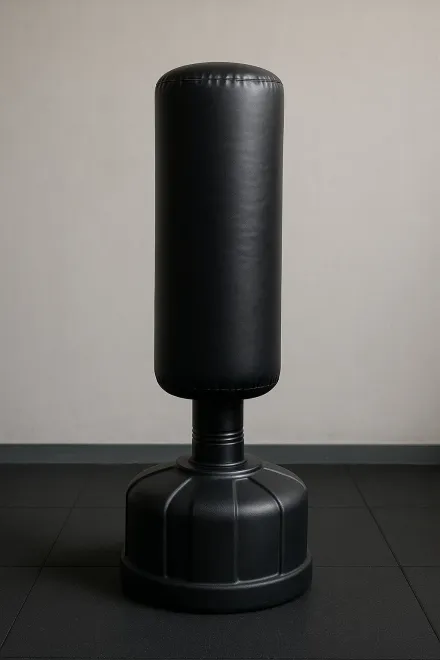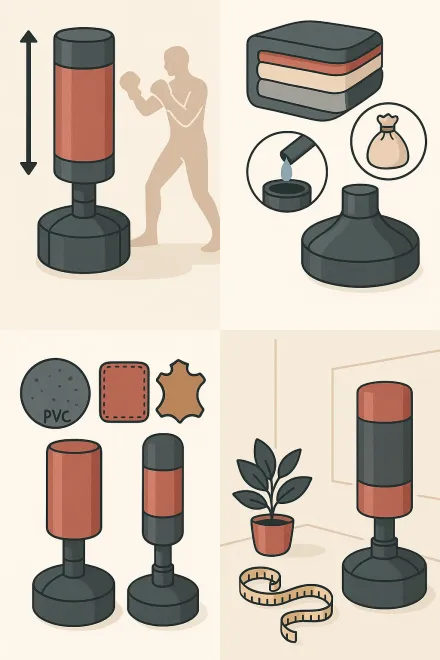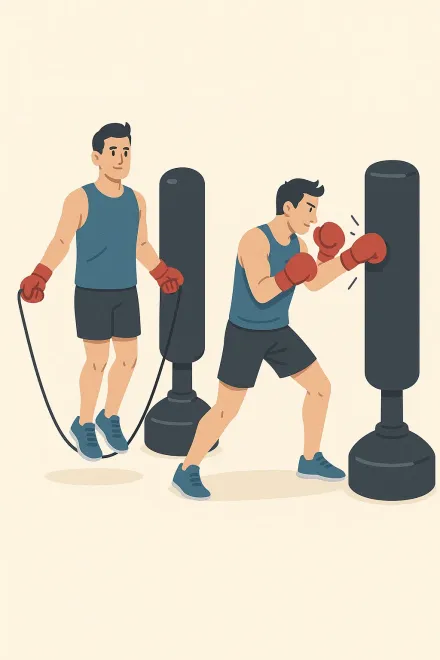Freestanding punching bags
Freestanding punching bags have become a very practical alternative to traditional bags that require chains or fixed ceiling mounts. These models stand out for their stability, easy setup, and versatility, making them ideal for training at home or in gyms. In this guide, you'll find all the information you need to choose the right freestanding bag for you, from its advantages to usage and maintenance tips.
See the best freestanding punching bag deals on Amazon
Advantages of training with a freestanding punching bag
The freestanding punching bag offers multiple benefits for practitioners of all levels, from beginners to advanced athletes. One of its main advantages is that it doesn't require complicated installation: just place it on the floor and fill the base with sand or water to ensure stability. This makes it a perfect option for those living in apartments or places where drilling ceilings or walls isn't possible.
Another positive aspect is its versatility. These bags allow you to train striking techniques for boxing, kickboxing, muay thai, or mixed martial arts. Adjustable height on some models makes it easier to work different kicks and combinations. In addition, because they're portable, you can move them easily according to your space needs.
Finally, training with a freestanding bag helps improve physical endurance, strength, coordination, and technique. It's a very complete training tool to boost overall fitness and relieve stress.
How to choose the right freestanding punching bag
To choose the best freestanding punching bag, it's important to consider several factors. First, check the height. Some models are adjustable, which is very useful if you want to practice low and high strikes or if several people will use it.
Another key aspect is the fill. Some bags come pre-filled with high-density foam, while others are hollow and need the base filled with water or sand. Sand offers more stability than water, although it makes the bag heavier and less easy to move.
The outer material is also essential. The most common options are PVC, synthetic leather, or natural leather. The first two are more affordable and wear-resistant, while natural leather is usually found in higher-end professional ranges.
Lastly, consider the available space. Although they're portable, freestanding bags take up a considerable area, so it's wise to measure the spot where you'll place it.


Tips for training with a freestanding bag
To get the most out of your freestanding punching bag, it's advisable to follow certain tips. First, make sure the base is well secured and filled to prevent excessive movement under impact. An unstable base can make you lose rhythm and keep you from working your technique correctly.
Start your workouts with a warm-up session of at least 10 minutes, including joint mobility and jump rope, to prepare your body and prevent injuries. Afterwards, perform punch and kick combinations, alternating higher- and lower-intensity rounds to train both technique and endurance.
Use boxing gloves or wraps to protect your hands and wrists. Hitting directly with the knuckles can cause skin, joint, or bone injuries.
Finally, alternate cardio- and technique-focused sessions with others emphasizing strength and power. This way, the freestanding bag becomes an ally for comprehensive, varied training.
Maintenance and care for your freestanding punching bag
Proper maintenance of your freestanding punching bag is essential to extend its lifespan and ensure safe training. The first step is to regularly check the condition of the cover. If it's synthetic leather or PVC, it's advisable to clean it after each use with a damp cloth and mild soap to prevent sweat and bacteria buildup. For natural leather, apply specific products to condition it and prevent cracking.
The base also needs attention. Check for leaks if you use water, or make sure the sand is well compacted. Some users add a rubber layer on the floor to reduce vibrations and protect the surface.
Another important point is the inspection of seams and joints. A worn or torn bag can cause accidents during training. If you notice damage, it's best to repair it as soon as possible or replace the bag if wear is advanced.
In addition to cleaning and inspection, it's wise to rotate the bag's position from time to time to distribute wear more evenly. This prevents striking the same area all the time, which extends durability.
By following these basic care steps, your freestanding punching bag will remain in excellent condition for years, ensuring effective and safe training.
Is it worth investing in a freestanding punching bag?
Investing in a freestanding punching bag is often very worthwhile, especially if you want a versatile, easy-to-install option. Unlike hanging bags, you don't need to drill into the ceiling or buy additional structures to mount it. This makes it the favorite option for home training, saving time and hassle.
Additionally, a freestanding bag offers great flexibility, since it can be moved from place to place as needed. You can set it in the living room, garage, or patio, and store it when not in use. Although they tend to be more expensive than traditional bags, the convenience they offer justifies the investment.
In terms of performance, a good freestanding bag allows intensive workouts with great stability, as long as the base is properly filled. Mid- to high-end models even include impact-absorption systems that reduce noise and vibration, which is ideal for training in apartments without disturbing neighbors.
In short, if you value convenience, portability, and versatility, a freestanding punching bag is a purchase well worth it. It's a tool that not only improves your combat technique but also supports your physical and mental health by enabling full workouts from home.
Frequently asked questions about freestanding punching bags
Is a freestanding punching bag stable?
A freestanding punching bag's stability depends mainly on its base. Filled with sand, it will be much more stable than with water, although also harder to move. In general, quality models offer strong anchoring and barely shift during training, as long as they are used on flat, firm surfaces.
Which is better, a freestanding bag or a hanging one?
The choice depends on your needs. A hanging bag offers a more realistic swinging feel, ideal for advanced training. In contrast, a freestanding bag is more practical, requires no installation, and can be moved easily. For home training, the freestanding option is usually the most convenient.
What is better for filling the base, water or sand?
Sand is more advisable because it provides greater stability and weight, preventing excessive movement. Water is easier to empty and transport, but it can create small leaks over time. A good approach is to combine both, adding sand first and then a little water to compact it.
Are freestanding bags suitable for kids?
Yes, there are models adapted for children with lower height and resistance, perfect for safe boxing or martial arts practice. In this case, it's important that the base isn't too heavy and that the bag's material is softer to avoid injuries.
Can I use a freestanding bag outdoors?
Yes, it can be used outdoors as long as the material is weather-resistant. It's advisable to protect it with a cover when not in use, especially if exposed to sun or rain, to avoid premature wear of the shell.
How long does a freestanding punching bag last?
Durability depends on material, use, and maintenance. A good-quality bag can last between 3 and 6 years with frequent use. If you clean it after each session, check the seams, and rotate its position, its lifespan can be extended considerably.
Can you hit a freestanding bag without gloves?
It isn't recommended. Even if the bag has padded covering, constant impacts without gloves can damage joints and skin. It's best to use boxing gloves or at least wraps to protect your hands and avoid injuries.
What sports can you practice with a freestanding bag?
The freestanding punching bag is very versatile and allows training in boxing, kickboxing, muay thai, full contact, or MMA. Thanks to its height and resistance, you can practice both punch and kick combinations, making it useful for improving technique across different combat styles.
